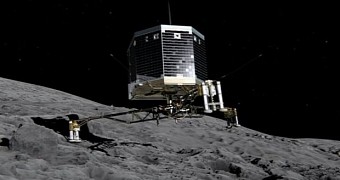The European Space Agency's Philae lander left Earth well over a decade ago, in March 2004, nestled atop the Rosetta spacecraft. The probe's target: Comet 67P/Churyumov-Gerasimenko.
Rosetta caught up with the orb in August 2014, and following a series of maneuvers, it managed to position itself in its orbit. Then, in last year's November, Philae broke free from the spacecraft and made a successful landing on the comet's surface.
A new video shows how the landing played out
While en route to its target, the Philae lander obtained several still images of the surface of the comet. The images, taken about 10 seconds apart and tracking Philae's descend, were combined to put together a video documenting the historic landing.
“Philae's descend: The director's cut,” mission scientists over at the European Space Agency call this video. If you have a couple of minutes to spare, scroll down to have a look at it yourselves.
The real-time footage, released just yesterday, documents the probe's descend starting from an altitude of about 67 meters (some 220 feet) and then all the way down to just 9 meters (roughly 30 feet).
The reason the video stops at this altitude is because the probe took less than 10 seconds to cover the remaining distance separating it from its target, and so it didn't get the chance to deliver a new view before touching ground, scientists explain.
Philae actually landed on the comet three times
When planning its mission, researchers instructed the Philae probe to land in a region dubbed Agilkia. The lander, however, proved a bit of a rebel and actually landed on Comet 67P/Churyumov-Gerasimenko a total of three times.
Thus, it appears that, rather than make one smooth landing, Philae bounced off the orb's surface twice and ended up in an unknown location that scientists are calling Abydos but whose exact whereabouts are still a mystery.

 14 DAY TRIAL //
14 DAY TRIAL // 